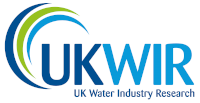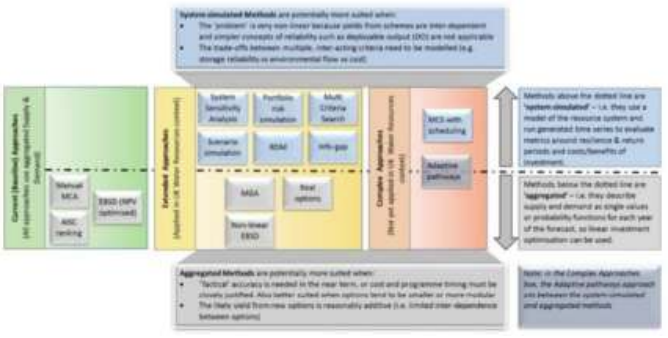Decision Making in Long Term Water Resources Planning (WRMP19)
The guiding principles for water resources planning1 outlined the following key policy priorities that the government expected water companies to address in their WRMP’s:
- Take a long term, strategic approach to protecting and enhancing resilient water supplies
- Consider every option to meet future public water supply needs
- Protect and enhance our environment, acting collaboratively
- Promote efficient water use and reduce leakage
In addition to the above, the updated Water Resources Planning Guidelines (WRPG2) required water companies to consider all of the most appropriate solutions for their systems taking into account:
- Customers’ preferences
- Costs and benefits (both monetary and non-monetary)
- Long-term best value
- Optimise long term solutions between companies
- Increase the resilience of your system to drought or other threats
- Develop resources for sharing and export (depending on need)
By moving from least cost towards a best value programme for WRMP19, it will be possible to integrate the above priorities into the decision making process to look beyond just financial cost.
UKWIR Tools and guidance
The Economics of Balancing Supply and Demand (EBSD) framework was developed for UKWIR by NERA in 2002 to assist public water supply companies in England and Wales in preparing their water resource plans. This framework and guidance had been widely accepted, used and understood. However, since 2002, planning priorities have changed, with the conventional EBSD least cost programme no longer always being the most appropriate method to adopt in situations where water companies face a future with a wide range of uncertainties.
With more emphasis now on customer engagement and the need to take into account climate change and resilience, more advanced planning approaches were developed that could consider and model these uncertainties in different ways. A new set of guidance3 for the decision making process, published by UKWIR, was followed by South East Water to select the most appropriate planning approach to develop a best value programme. Using this new guidance whilst maintaining the current EBSD approach to provide a benchmark demonstrated how the best value programme compares to the conventional least cost one. How we used the project to improve our decision making from WRMP14 to WRMP19 is illustrated in Annex A.
Extract from the UKWIR Project Report – mapping the decision making methods and tools
Using the project to develop our approach
South East Water undertook an assessment of the uncertainties and risks we faced over the course of the planning horizon. In accordance with the decision making guidance4 (UKWIR 2016), we determined that the most appropriate level of assessment for the company was to focus on a regional level appraisal, and to drill down to resource zones, and individual sources where it is felt appropriate to explore in more detail.
SEW’s Problem Characterisation assessment resulted in a majority risk score of 1 (where 0 is the lowest risk and 2 is the highest). This is because the company was operating within a region of medium to high forecast population growth and restricted supply availability.
It was therefore determined that the company has a moderate level of concern regarding the risks and vulnerabilities faced in addressing future water resource needs. To deal with this level of concern, we decided to apply more than one extended approach to decision making in its Water Resources Management Plan for 2019, as recommended by the UKWIR guidance4.
Putting the project into practice
South East Water commissioned a consultant to develop a decision making tool/model. In its base operation, the tool/model was used for least cost programme selection using the EBSD methodology. Least cost included Capex, Opex and monetised Carbon and Environmental/Social costs. This least cost programme was used to provide a benchmark for comparison against alternative best value programmes.
The EBSD least-cost model used an annual time step and its level of special aggregation is the water resource zone (WRZ). It made two types of decisions over a designed planning horizon: which scheme to implement and in which year, in order to meet forecast demands at minimum cost.
Once the least-cost solution was identified, we generated multiple planning solutions (schedule of schemes) by running the least-cost EBSD model under a number of different scenarios. The supply-demand scenarios represented the most likely futures the company may experience over the planning period and take account of uncertainty on Climate Change, Drought, and Water Quality and Sustainability Reduction issues. The model returned optimal least-cost plan under each of these scenarios. This is represented in Annex B.
We assessed how these planning solutions performed against a set of other metrics in addition to NPV costs. A total of five metrics were used, i.e. NPV Cost, Environmental & Social Acceptability, Promotability, Deliverability and Resilience. For each selected scheme, NPV costs were given by the discounted sum of Capital expenditures, Fixed and Variable operating costs as well as Monetised Carbon and E&S. The remaining four criteria were qualitative metrics and are defined at option level. For each scheme, these four metrics were translated into a score between 0 to 10. In order to compare all alternative programmes, scores were averaged at programme-level. Parallel axis plots 4 WRMP19 Methods - Decision Making Process: Guidance (16/WR/02/10), published by UKWIR in 2016 were then used to visualise the MCA outputs for all the programmes (including the least-cost one). This helped to identify a shortlisted number of programmes for stress testing.
Three levels of stress testing were executed to assess how well each of the shortlisted portfolios performed under a range of future scenarios. First, we tested the portfolios’ level of resilience under uncertainty on DI, Climate Change, Drought, Water Quality and Sustainability Reduction data. The set of options in each programme was fixed but the timing of options’ implementation could vary during each of the scenarios. The results of this analysis told us how resilient each of the programmes was to a changing future by identifying the impact on the supply/demand balance (e.g. deficit or surplus) for each portfolio. Second, the portfolios were stressed tested under the impact of extreme storms causing outage events (flood, water quality and power loss). Third, the portfolios were stressed tested under the impact of contamination spills causing outage events (forced emptying of a reservoir).
Finally, in the refinement phase expert judgement (in discussion with regulators and stakeholders) was used to identify alternative programmes. This phase helped the company to understand better what additional options, over and above its preferred programme of options, might be required in order to develop a plan that is resilient to the most plausible future and accepted by stakeholders. Summary of
SEW’s decision-making tools and selection techniques
Tool | Selection | Notes |
|---|---|---|
EBSD [Current Approach] | Mathematical programming | Linear optimisation to identify the least cost solution. |
EBSD+ [Extended Approach 1] | Mathematical programming | Some system’s non-linearities can be dealt using mathematical programming. For example, Active Leakage Control options will be described through cost curves (cost vs leakage reduction) that can be piece-wise linearised. |
Scenario Analysis [Extended Approach 2] | Mathematical programming | Generation of multiple solutions using the least-cost EBSD model under a number of different supply/demand balance input assumptions. This returns programmes (schedule of schemes) each optimal under one scenario. |
Multi-Criteria Analysis [Extended Approach 3] | Ranking Expert Judgement | The optimised programmes are visualised using a parallel axis plot, which shows how the programmes perform according all MCA metrics in addition to cost. Parallel axis plot allow to systematically review and filter amongst a large numbers of programmes across MCA metrics. |
Stress Testing [Extended Approach 4] | Mathematical programming | Using principles of Infogap analysis to systematically vary the input supply and demand values and/or costs within the EBSD model to identify the extent of SDB failures due to future uncertainties. Specifically, the performance of the programmes (generated with the “Extended Approach 1”) are tested over the whole series of supply-demand balance scenarios. The set of options in each programme will be fixed (coherently with work undertaken in WRSE, for stress testing) but the timing of option implementation can vary during each of the scenarios included in the uncertainty analysis. This will give an idea of how resilient the solutions are under a series of possible SDB scenarios. |
“With the step change in level of complexity required in the updated Water Resources Planning Guidelines for WRMP19, the UKWIR decision making report and guidance allowed us to develop a coherent and easy to follow
approach to develop a best value plan that was acceptable to customer and stakeholders and approved by our regulators”.
Andrew Halliday
Water Resources Strategy Manager – South East Water
1 Guiding Principles for Water Resources Planning, published by DEFRA in May 2016
2 Water Resources Planning Guideline, May 2016, published by the Environment Agency.
3 WRMP19 Methods - Decision Making Process: Guidance (16/WR/02/10), published by UKWIR in 2016
4 WRMP19 Methods - Decision Making Process: Guidance (16/WR/02/10), published by UKWIR in 2016

